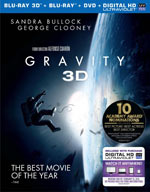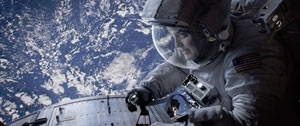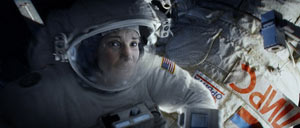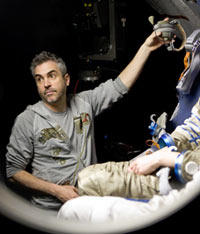
Gravity (3D)

 – for intense perilous sequences, some disturbing images and brief strong language.
– for intense perilous sequences, some disturbing images and brief strong language.
Director: Alfonso Cuarón
Starring: Sandra Bullock, George Clooney, voice of Ed Harris
Running Time: 1 hour, 31 minutes
Theatrical Release Date: October 4, 2013
Blu-Ray Release Date: February 25, 2014 (Amazon.com)
Official Site
Plot Summary
Bullock plays Dr. Ryan Stone, a brilliant medical engineer on her first shuttle mission, with veteran astronaut Matt Kowalsky (Clooney) in command of his last flight before retiring. But on a seemingly routine spacewalk, disaster strikes. The shuttle is destroyed, leaving Stone and Kowalsky completely alone—tethered to nothing but each other and spiraling out into the blackness.
(from MovieWeb.com)

Film Review
Usually when a film makes a significant splash at the box office, collecting copious amounts of hype along the way, mixed reception from those who subscribe to the hype is inevitable. 2009’s Avatar is a good example of a film that fits such a description; it brought people back to the theater over and over, but polarized its audiences in the process. And soon it became yet another film that people love to criticize even though they once thought it had been the best film they’d seen in years (if not ever). The latest film to attract significant attention (but not quite luring the staggering droves as the aforementioned blockbuster) is the space epic Gravity, a film which uses special effects in extreme amounts to drive a film that tackles loneliness and death head-on in a fresh and intense way.
It’s easy to admit; Gravity is a stunning film visually. But like with Avatar, special effects can’t be everything. And that’s precisely why Alfonso Cuarón enlisted the talents of Sandra Bullock and George Clooney to singlehandedly carry this film. Granted, space itself is a character in this film, serving as almost a villain for these characters. When a space mission goes horribly wrong, Bullock’s Ryan Stone and Clooney’s Matt Kowalski are left alone to fend for themselves. And, to some viewers’ surprise, these two are literally the only folks we see in this movie.
Cuarón is probably the perfect man for the job when directing a film like this one. Most of the opening of the film is one fluid shot without a single sign of there being a cut in the film. Because of this, we see the camera move around the action as if there were truly a cameraman documenting this space mission, and then Cuarón literally takes us inside the characters’ space suits and we get to see things from a first-person view. It makes the movie mold around the viewer, forcing them into the action, and the 3D presentation helps create this feeling. However, because of the seamless cuts that he utilizes throughout the film, Cuarón doesn’t mind spinning the camera and disorienting the viewer to give an accurately unnerving experience to the viewer and help recreate in them the terror that the characters are experiencing. If you’re prone to motion sickness or dizziness, just be warned that Cuarón’s cinematography is certainly dizzying and not for the squeamish.
The biggest problem Gravity has is in the increasing need for the audience to suspend its disbelief. It’s obvious that Cuarón is aiming for realism from the film’s start; there are no aliens or supernatural forces at work here. Gravity is more about the examination of human character, our will to live, our response to death (our own and others’) and even our spirituality to a small degree. But as the film moves forward, Cuarón continues to push the limits of believability as things worsen and some characters seem to have the worst possible “luck” one could have (or, let’s face it, just a really, really bad day). But when things happen at just the last possible moment for the second or third time, it’s tough to overlook it. It’s one thing to shoot for realism and then toss it out the window, and another to just aim for fantasy from the start and stick to it. Gravity isn’t Star Trek or Star Wars; Cuarón paints the picture that this could be happening right now in our atmosphere, or merely in the not-so-distant future. And the finale may be a bit too much for a movie that seemed to pride itself on a less-is-more approach. When the final moments unfold before our very eyes, one has to wonder if we’re about to watch an entirely different kind of sci-fi adventure film being set up than what the previous hour and a half had been leading up to (perhaps something from Franklin J. Schaffner?). And don’t get me started on a passing quip about Facebook that felt like a thinly veiled attempt at product placement in a film will little to no space to place products.

But these hiccups aren’t quite enough to rain on Cuarón’s parade (obviously so, since it’s impacting audiences everywhere). Bullock and Clooney really are solid here, and they bring a lot to their characters (even if Clooney’s is more underwritten). Gravity keeps the audience on their toes, and if all mayhem isn’t breaking loose around them, there are some strong character moments being created on screen. Death is a very big theme in the film, and one character openly addresses the potentially impending doom and tries to make peace with it. Others go suddenly and the mortality and helplessness of the human race is ever so apparent here. Cuarón focuses on the spiritual imagery of Jesus in one scene and Buddah in another to bring that deeper element into play here (but neither belief is specifically focused upon other than those single images). And things get a little emotionally weighty when a character ponders the loss of a child years prior and the hopes of seeing them again. Cuarón makes the fear and emotion very tangible here, and it needs to be noted that the intense score from Steven Price adds wonderfully to this. Because Cuarón adheres to the truth that there’s no sound in space, he utilizes Price’s score to its greatest potential when sound effects would otherwise be needed.
The content for Gravity is a solid PG-13. The intensity of the subject matter is worthy of the rating alone, but there’s some graphic content that creeps into one sequence. After the initial satellite debris impact that disables the team’s shuttle, we see a man who’s been hit by flying debris whose faceplate has shattered. As such, we see that there’s a hole right through most of their frozen face. It’s quite graphic and we can see all the way through their head and out the back of it. We also see some blood frozen around the wound and some inside gore within the wound. The camera lingers on this view a little longer than it needs to, too. We also see two non-gory views of people’s faces who have frozen to death in the vacuum of space. Otherwise, there’s some profanity sprinkled throughout the film, mostly from Bullock who uses the “F” word pretty early on, with additional uses of the “S” word, “h*ll” and several others throughout the movie. (It really wasn’t necessary, but at least it had been curbed to secure a PG-13 rather than an R rating.)
Overall, Gravity is a visual cinematic achievement and an experience like few others. However, you probably shouldn’t buy into all the hype too quickly because the film is far from perfect. Still, Alfonso Cuarón has definitely created something that will give audiences food for thought for some time. Riveting, engaging, and visually stunning, Gravity isn’t for everyone, but it’s at least worth a viewing on the big screen.
– John DiBiase, (reviewed: 10/13/13)
Blu-Ray Special Features Review
You can get Gravity through any of the digital retailers early or on 3D Blu-Ray with a 2D Blu-Ray disc, a DVD and an Ultraviolet copy. It’s also available in a 2D Blu-Ray/DVD/Ultraviolet set and on DVD separately. I watched Gravity in 3D in the theaters and then in 2D on Blu-Ray and again in 3D on Blu-Ray. It’s one of the better 3D Blu-Rays out there, but I actually didn’t think it lost anything when I watched it in 2D. However, the picture is so gorgeous that I would not recommend seeing it in anything but high definition. The 3D looks cool, too, but there are times where the action looks choppy and some of the space shots look flat (due to the 3D effect). However, there are some incredible shots too, like when we see just an astronaut floating out in space alone or when Stone is inside the capsule.
Seeing the movie a second (and third time), I definitely liked it more than the first viewing. The hype was way too high, but Gravity remains an entertaining and visually breathtaking film. Also, the sheer terror of being lost in space the way it’s portrayed here really adds a thrilling and scary tension to the story.
There are no extras on the 3D Blu-Ray disc, but the 2D Blu-Ray disc has roughly 3 hours of extra content. And most of it is quite interesting and worth watching. In the behind-the-scenes content, they go in-depth on how the story was conceived and it all came together.
Aningaaq: A Short Film by Jonas Cuaron (10:11) – With an introduction from the filmmakers, we get this short film that isolates a transmission sequence from the feature film and shows you the other side of the conversation (which we otherwise do not see in the feature film). It’s kind of neat, although not necessary, but it gives the viewer additional information for that scene in Gravity if you watch it again. However, I’ve seen some comments online from viewers who felt it ruined the scene in the movie for them.
Gravity: Mission Control (1:46:36) – This is the honeypot of the bonus content. “Mission Control” is broken down into 9 separate segments, but there’s a Play All option to watch them all together — and it clocks in at longer than Gravity itself:
“It Began with a Story” – The writer and director talk about the birth of the story and its intent, the characters and their development. Here, they also cover some of the deliberate symbolism seen in the film and how they compare Stone’s character development to rebirth and literal evolution.
“Initial Challenges: Long Shots and Zero G” – Here, we find out the film took about 4 and a half years from the conceptualization of it to its completion. They talk about the long cuts in the film and how they accomplished the closeups. They tried to use actual zero gravity to do the space shots, trying out the “vomit comet,” but realized it was impossible. It’s when they decided to use animation to pull it all off that the film really came together. Most of what you see in Gravity is completely animated.
Previsualizing Gravity – It took 10 months to previsualize the film, and they decided to use those animated previs sequences to be the basis for the animated finished film. They needed to create brand new rigs that had never been used before to properly levitate and light the actors. So they literally built an LED light box around Sandra Bullock.
The Hues of Space – Here they talk about plotting out where over the Earth the characters would be and how to color it on film. We also see more behind-the-scenes shooting in the LED box.
Physical Weightlessness – It took 6 or so different rigs to create Sandra’s weightlessness. And we also learn how she had to prepare for it. They also ended up puppeteering her like a marionette!
Space Tech – They aimed to use current space technology instead of making it look sci-fi or futuristic. They also explain how almost all of the props seen in the movie were completely digital but based on real items. We do find out here, though, that some of the interior sets were real.
Sandra and George: A Pair in Space – Sandra talks about utilizing her background in dance to prepare for the physical stunts. And we hear her talking about her literal isolation and being all alone a lot while filming. We also see some great on-set footage of Sandra and George together (and goofing around).
Final Animation – Here, they talk about rendering the film, and how there was something like 500 terabytes of data, which would fill up about 25,000 iPods. At one point, they said how the look of the movie could be viewed right side up or upside down and when someone showed that to the director, he asked them to flop a short shot for the finished film. This ended up taking 3 additional months to complete because they had to create the imagery that was missing from the shot when it was rotated!
Complete Silence – In the final video, they talk about the sound of the movie being represented from the perspective of the characters, since there’s no sound in space. Composer Steven Price shares his musical brilliance and talks about how he approached scoring the film, the way it moves through the speakers and multiple melodies are used to represent the action and fill in for the silence. It’s amazing! He goes through its textures and the evolution of the music and melodies through the course of the movie.

Shot Breakdowns (36:48) – The next big section of behind-the-scenes featurettes totals almost forty minutes, and they show you how certain key scenes were created:
Behind the Visor – While the actors wore the space suits, they never had a visor over their face; it was always digital! So they talked about how that was achieved and how the breathing of the actors was used to provide tension in the film.
Fire in the International Space Station – Here we see how they filmed it while Sandy was on a rig and they talk about the physics of fire in zero gravity.
Dr. Stone’s Rebirth – The imagery of Sandra in the “womb” of the airlock was an idea the filmmakers had from the beginning, so they discovered quite a few challenges when they went to actually make it a reality. Here we get to see how Sandra was mounted on a special rig to make it work.
The Sound of Action in Space – This is more about Price’s musical score and he deconstructs it piece by piece to show you how it moves with the action in the movie.
Splashdown – This talks about the evolution symbolism in the finale, which is rather over the top and nearly ruined the film for me, personally. The last minute or so of the movie feels so tacked-on and goofy that it just feels like it’s not even part of the right movie. They stress how much they were aiming for realism and then they give it this overly dramatic and strange finish.
Documentary: Collision point: The Race to Clean Up Space – Narrated by Ed Harris (22:28) – This is a documentary about space junk in space being a problem in cluttering up the space around Earth. When you start the documentary, it has the tone of being informational in a way that’s meant to bring awareness to a serious problem… and then it ends with an urging of the viewer to write letters to politicians to ask for something to be done about it. The whole thing is super silly and has no place on this Blu-Ray set, to be blunt. This is more of a problem for those involved in NASA and the people who created this isolated mess to deal with — not the average movie viewer. I honestly never thought I’d ever see an environmental documentary urging people to join in the fight against debris in space and guilting movie viewers into helping.
– John DiBiase, (reviewed: 2/9/14)
Parental Guide: Content Summary
![]() Sex/Nudity: We see Stone in short shorts and a tank top; Kowalski tells the story of a man looking for a woman during Mardi Gras and finding her holding hands with a “hairy man” but then he reveals that it wasn’t a hairy man at all, and is interrupted before he can finish the story. Stone later asks him about the “hairy man” story.
Sex/Nudity: We see Stone in short shorts and a tank top; Kowalski tells the story of a man looking for a woman during Mardi Gras and finding her holding hands with a “hairy man” but then he reveals that it wasn’t a hairy man at all, and is interrupted before he can finish the story. Stone later asks him about the “hairy man” story.
![]() Vulgarity/Language: 1 “F” word (and another cut off); Roughly: 8 “S” words, 9 “h*ll,” 1 “J-sus Chr-st,” 2 “G-d,” 3 “d*mn,” 1 “S.O.B,” 1 “a” word.
Vulgarity/Language: 1 “F” word (and another cut off); Roughly: 8 “S” words, 9 “h*ll,” 1 “J-sus Chr-st,” 2 “G-d,” 3 “d*mn,” 1 “S.O.B,” 1 “a” word.
![]() Alcohol/Drugs: Kowalski talks about the Russians having vodka on their space station; We briefly see a man drinking from a flask.
Alcohol/Drugs: Kowalski talks about the Russians having vodka on their space station; We briefly see a man drinking from a flask.
![]() Blood/Gore: A man who’s been hit by flying debris in space has his faceplate shattered and we see that there’s a hole right through most of their frozen face. It’s very, very graphic and we can see all the way through their head and out the back of it. We also see some blood frozen around the wound and some inside gore within the wound. The camera lingers on this view for more than just a brief moment; Stone has a slightly bloody cut on her cheek; We also see two non-gory views of people’s faces who have frozen to death in the vacuum of space.
Blood/Gore: A man who’s been hit by flying debris in space has his faceplate shattered and we see that there’s a hole right through most of their frozen face. It’s very, very graphic and we can see all the way through their head and out the back of it. We also see some blood frozen around the wound and some inside gore within the wound. The camera lingers on this view for more than just a brief moment; Stone has a slightly bloody cut on her cheek; We also see two non-gory views of people’s faces who have frozen to death in the vacuum of space.
![]() Violence: SPOILER ALERT… Debris hits a NASA shuttle in space, killing several crew members; A person is thrown into space and keeps spinning uncontrollably; A person drifts off into space, presumably dying; A fire breaks out inside a space station. When a person tries to put it out with a fire extinguisher, the force of it slams them back against the wall; A pod is whipped around when it is tangled up with a space station; A person angrily pounds a console in frustration; A capsule starts to burn up on entry but crash lands in water. When the hatch is removed, it begins filling up with water, nearly drowning the person inside, and it sinks.
Violence: SPOILER ALERT… Debris hits a NASA shuttle in space, killing several crew members; A person is thrown into space and keeps spinning uncontrollably; A person drifts off into space, presumably dying; A fire breaks out inside a space station. When a person tries to put it out with a fire extinguisher, the force of it slams them back against the wall; A pod is whipped around when it is tangled up with a space station; A person angrily pounds a console in frustration; A capsule starts to burn up on entry but crash lands in water. When the hatch is removed, it begins filling up with water, nearly drowning the person inside, and it sinks.
